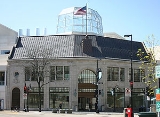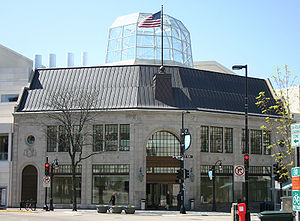
Overture Center
Encyclopedia
Overture Center for the Arts is a performing arts center
and art gallery
in Madison, Wisconsin
, which replaced the Civic Center. The center was commissioned by Jerome Frautschi, designed by Cesar Pelli
, and built by J.H. Findorff and Son. Flad Architects
and Potter Lawson (both Madison-based firms) led the project as executive architect. Frautschi paid $205 million to construct the building, making it the largest private gift to the arts of its kind. The center also houses the Madison Museum of Contemporary Art
.
The center first opened on September 19, 2004.

, Madison Opera
, and Madison Ballet
call this theater home. In addition to local Madison performing groups, a variety of touring performances have played in Overture Hall; comedian Jerry Seinfeld
and musician Yo-Yo Ma
are examples of nationally famous performers who have appeared here.
Barton Organ Company
. Resident companies include the Wisconsin Chamber Orchestra
and CTM Madison Family Theatre, although some traveling shows (usually concerts) occasionally perform there.
The theater's inaugural performance upon reopening took place on September 19, 2004. At the time of opening the President/CEO was Robert B. D'Angelo who was succeeded by Michael Goldberg who served on an interim basis. Dr. Thomas Carto assumed the help in January of 2007.
In addition, the center houses the James Watrous Gallery, which is operated by the Wisconsin Academy of Sciences, Arts and Letters. This gallery features larger exhibits and installations from regional artists.
Both galleries are open to the public.
, the Overture has been the subject of several controversies. After Frautschi's initial gift, some citizens complained that the City of Madison's priorities were skewed. Others said the project would hurt the image of nearby State Street. Still others believed it would be accessible only to the wealthy while limiting access to local and smaller acts and artists.http://www.madison.com/archives/read.php?ref=/tct/1999/07/22/9907220350.php
After initial construction of the center, concerns were raised over additional funding. Citizens became concerned that as the economy slowed down Overture's reserve funds would decrease. As this happened, the potential was raised for the City of Madison to step in to maintain funding levels. Some were worried that a project that was supposed to be private would become an unnecessary burden to taxpayers. These fears were exacerbated by the liquidation of the trust fund that was set up to pay the construction debt for the building as well as provide some operating income.http://www.madison.com/archives/read.php?ref=/tct/2008/09/20/0809200073.php The liquidation left some construction debt that will be paid by a number of parties, and forced the center to cut staff due to the loss of the operating income.
Performing arts center
Performing arts center, often abbreviated PAC, is used to refer to* A multi-use performance space that is intended for use by various types of the performing arts, including dance, music and theatre....
and art gallery
Art gallery
An art gallery or art museum is a building or space for the exhibition of art, usually visual art.Museums can be public or private, but what distinguishes a museum is the ownership of a collection...
in Madison, Wisconsin
Madison, Wisconsin
Madison is the capital of the U.S. state of Wisconsin and the county seat of Dane County. It is also home to the University of Wisconsin–Madison....
, which replaced the Civic Center. The center was commissioned by Jerome Frautschi, designed by Cesar Pelli
César Pelli
César Pelli is an Argentine architect known for designing some of the world's tallest buildings and other major urban landmarks. In 1991, the American Institute of Architects listed Pelli among the ten most influential living American architects...
, and built by J.H. Findorff and Son. Flad Architects
Flad Architects
Flad Architects is an employee-owned, national architectural firm headquartered in Madison, Wisconsin, with additional offices in Atlanta, Georgia; Gainesville, Florida; Raleigh, North Carolina; San Francisco, California; Stamford, Connecticut; and Tampa, Florida...
and Potter Lawson (both Madison-based firms) led the project as executive architect. Frautschi paid $205 million to construct the building, making it the largest private gift to the arts of its kind. The center also houses the Madison Museum of Contemporary Art
Madison Museum of Contemporary Art
The Madison Museum of Contemporary Art — MMoCA, formerly known as the Madison Art Center, is an art museum located in Madison, Wisconsin. A three-story glass facade "icon" on the corner of State and Henry Streets serves as the museum's main staircase, as well as its architectural...
.
The center first opened on September 19, 2004.

Overture Hall
The 2251-seat Overture Hall is the facility's largest theater. Consisting of four levels of seats, it has a striking architectural style. The balconies are noted for their "continental-style" seating arrangement, where aisles other than those on the sides of seat rows are omitted in order to provide, according to designers, greater seat size. It also features a large, permanent organ by the German organ builder Klais. The Madison Symphony OrchestraMadison Symphony Orchestra
The Madison Symphony Orchestra is an orchestra headquartered in Madison, Wisconsin. Its conductor is John DeMain, who began his 14th season with the orchestra in the fall of 2007...
, Madison Opera
Madison Opera
Madison Opera is a regional opera company based in Madison, Wisconsin. It was founded in 1961 as an extension of the and came to national prominence with the commissioning and premiering of Shining Brow, the opera about Frank Lloyd Wright by composer Daron Hagen and librettist Paul Muldoon. The...
, and Madison Ballet
Madison Ballet
The Madison Ballet was founded in 1981 as the Wisconsin Dance Ensemble in Madison, Wisconsin.-School of Madison Ballet:In addition to its professional performances, Madison Ballet has run the School of Madison Ballet since 2005...
call this theater home. In addition to local Madison performing groups, a variety of touring performances have played in Overture Hall; comedian Jerry Seinfeld
Jerry Seinfeld
Jerome Allen "Jerry" Seinfeld is an American stand-up comedian, actor, writer, and television and film producer, known for playing a semi-fictional version of himself in the situation comedy Seinfeld , which he co-created and co-wrote with Larry David, and, in the show's final two seasons,...
and musician Yo-Yo Ma
Yo-Yo Ma
Yo-Yo Ma is an American cellist, virtuoso, and orchestral composer. He has received multiple Grammy Awards, the National Medal of Arts in 2001 and the Presidential Medal of Freedom in 2011...
are examples of nationally famous performers who have appeared here.
Capitol Theater
During Overture construction, the Oscar Mayer Theater [originally built in 1928 as a movie theater] was restored, downsized, and re-christened the Capitol Theater. Done in muted teal and fuchsia, it holds approximately 1000 people in the main floor and balcony. Original to the theater is an organ built by Oshkosh'sOshkosh, Wisconsin
As of the census of 2000, there were 62,916 people, 24,082 households, and 13,654 families residing in the city. The population density was 2,662.2 people per square mile . There were 25,420 housing units at an average density of 1,075.6 per square mile...
Barton Organ Company
Barton Organ Company
The Barton Organ Company was an American pipe organ manufacturer during the age of silent movies. The company was founded by Dan Barton, who was from Amherst, Wisconsin. The fifth largest builder of theater instruments in the nation, Barton focused almost exclusively on the Midwest market...
. Resident companies include the Wisconsin Chamber Orchestra
Wisconsin Chamber Orchestra
The Wisconsin Chamber Orchestra is a professional chamber orchestra in Madison, Wisconsin. Its current conductor, Andrew Sewell, began his tenure with the orchestra in 2000. It was founded in 1960 by Gordon B. Wright...
and CTM Madison Family Theatre, although some traveling shows (usually concerts) occasionally perform there.
The theater's inaugural performance upon reopening took place on September 19, 2004. At the time of opening the President/CEO was Robert B. D'Angelo who was succeeded by Michael Goldberg who served on an interim basis. Dr. Thomas Carto assumed the help in January of 2007.
Playhouse
This smaller, intimate performance space replaced the former Isthmus Playhouse. It was renovated with the Madison Repertory Theatre in mind as its resident company http://77square.com/arts/theater/story_441183, and was occupied by Madison Rep until its closure in March 2009.http://77square.com/arts/theater/story_441928Promenade Hall
This is a smaller room featuring bleachers in the walls which can convert it to a performance space. Kanopy Dance is its resident company.Rotunda Stage
This room, located in the lower level, is used for the center's Kids in the Rotunda performances. The only venue accessible to the public during regular hours, it features a bright, distinct color scheme of fuchsia walls and floors, as well as permanent audience riser seats. It is also a venue for banquets, meetings and other performances.Wisconsin Studio & Rotunda Studio
These two venues are used mainly for rehearsals and meetings.Visual Art Galleries
The center also contains four visual art galleries. The Overture Galleries feature a variety of exhibits by local and state artists and organizations.In addition, the center houses the James Watrous Gallery, which is operated by the Wisconsin Academy of Sciences, Arts and Letters. This gallery features larger exhibits and installations from regional artists.
Both galleries are open to the public.
Controversy
Much like Monona TerraceMonona Terrace
Monona Terrace is a convention center on the shores of Lake Monona in Madison, Wisconsin.-Controversy:...
, the Overture has been the subject of several controversies. After Frautschi's initial gift, some citizens complained that the City of Madison's priorities were skewed. Others said the project would hurt the image of nearby State Street. Still others believed it would be accessible only to the wealthy while limiting access to local and smaller acts and artists.http://www.madison.com/archives/read.php?ref=/tct/1999/07/22/9907220350.php
After initial construction of the center, concerns were raised over additional funding. Citizens became concerned that as the economy slowed down Overture's reserve funds would decrease. As this happened, the potential was raised for the City of Madison to step in to maintain funding levels. Some were worried that a project that was supposed to be private would become an unnecessary burden to taxpayers. These fears were exacerbated by the liquidation of the trust fund that was set up to pay the construction debt for the building as well as provide some operating income.http://www.madison.com/archives/read.php?ref=/tct/2008/09/20/0809200073.php The liquidation left some construction debt that will be paid by a number of parties, and forced the center to cut staff due to the loss of the operating income.

